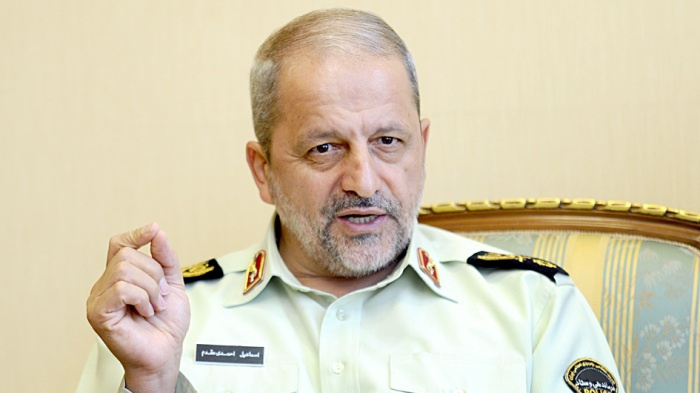The Elite vs. Ahmadinejad

'Nagofteha’, ‘the unsaid’ of Iranian politics, has turned into a popular genre in Iranian media in the recent years. The recent interview by Esmaeil Ahmadi-Moghaddam, former chief of Iran’s police forces, with the website Tarikh-e Enghelab (The History of Revolution), is one of the most interesting of the genre, where he speaks of the background to 2009 presidential election and eight months of protests by supporters of candidates Mir Hossein Mousavi and Mehdi Karroubi.
THE BACKDROP TO 2009 ELECTIONS
Ahmadi-Moghaddam starts the interview with a configuration of electoral camps before the presidential elections of 12 June, 2009 and the alliance between Hashemi Rafsanjani, the Reformists ("the Left"), and moderate Principlist forces: “for Reformists, presidency of a person like Ahmadinejad was insufferable. Ahmadinejad’s behavior and conduct in both 2005 presidential elections and afterwards, and his attacks on Hashemi, [Reformist pro-Hashemi party] Kargozaran, and other forces close to Hashemi and the Left was a catastrophe.” Former police chief also points to the position of the former speaker of the parliament and moderate conservative patron Akbar Nategh Nouri, and 2005 presidential candidate and the incumbent speaker of the parliament Ali Larijani in the anti-Ahmadinejad camp: “they may have had disagreements over their favorite candidate, but they all agreed that Ahmadinejad should not be [in power].” According to Ahmadi-Moghaddam, in the political circles, “elite and parties were all against Ahmadinejad”.
MOUSAVI ENTERS
Former police chief also addresses Ahmadinejad’s estimation of his own popularity vis-à-vis the Reformists and his decision to knock them out once and forever. As the 2009 election approached Ahmadinejad repeatedly asked me to let Khatami step in for the election. The former president had had even negotiated with the Guardian Council, the body in charge of qualifying electoral nominees, to allow for Khatami’s participation. Ahmadinejad believed that if Khatami ran for the elections, he would lose in the very first round “and their story would end” forever. However, Mir Hossein Mousavi’s rising popularity had caught Ahmadinejad off-guard according to Ahmadi-Moghaddam: “Mir Hossein was widely welcomed when he stepped amid intense media coverage. Ahmadinejad was surprised and worried after receiving several reports on Mousavi’s reception. Ten days before the election, Ahmadinejad suddenly increased the number of his provincial tours, and traveled to two or three provinces every day.”
POLICE AND THE POST-ELECTION PROTESTS
The unexpected results of the election, a 63% vote for Mahmoud Ahmadinejad, were fiercely rejected as vote rigging by the three other candidates, Mir Hossein Mousavi, Mehdi Karroubi, and Mohsen Rezaei. Tehran witnessed massive protests, largest since the Islamic Revolution, for the next eight months. Chain of demonstrations drained police resources. The Kahrizak incident, in which four detainees lost their lives in detention center, created a negative reputation for the disciplinary forces.
Although a “media monitoring room” was established by the police a few months before the elections in order to track Reformists’ media campaign, Ahmadi-Moghaddam admits confusion in decoding the structure of the Green Movement network. During the chain of demonstrations, the police could not find out “how do they bring placards? How do they coordinate the slogans? How do they guide people?" before they finally busted the network.” Former police chief also points to the powerful role of social media in coordination of protests by the Green Movement supporters: “in 2009, social media were gradually gaining popularity and we were oblivious to that. The Left was using social tools such as Facebook, Twitter etc. effectively to carry on its plans, while we had no plans for that part.”
Former police chief also gives a backhanded compliment to Mohammad Khatami, Reformist president (1997-2005) and a supporter of Mir Hossein Mousavi. “Khatami is clever” says Ahmadi-Moghaddam in the interview. “He showed caution since the beginning [of the protests]. For instance, he did not use the term ‘Green Movement’ and separated his way from the outset. He also didn’t the use the word ‘fraud’ [for the election] so as to create an escape route for himself. He didn’t attack the Supreme Leader. He set red lines for himself and those red lines now distinguish him from Mousavi and Karroubi.” Comparing Khatami to Hashemi Rafsanjani, another leader of the ‘sedition’, former police chief says: “we can even say that his actions and behaviors were not worse than those of Hashemi; though with no doubt they were all coordinated backstage. I think if Khatami was the leader [of the movement] he would wrap up the protests sooner than this.”
JUNE 15, 2009
Demonstrations on June 15 were the most significant, both for the scale of the protest and for its aftermath. The number of demonstrators is still a matter of dispute. Although he had previously spoken of one million-strong demonstration, in this interview Ahmadi-Moghaddam speaks of 350 to 500 thousand demonstrators, a number that he claims the Reformists "inflated to two or three million." However, he adds that even a 2-million strong demonstration would not be surprising, since Mousavi had gathered around 2 million and 300 thousand votes in Tehran.
The June 15, 2009 demonstrations will be also remembered with shootings that happened in a Basij station near Azadi square which led to the death of several demonstrators. Ahmadi-Moghaddam attributes the responsibility to the demonstrators, whom he claims were residents of the northern, more affluent parts of the city: “after the demonstration was over, the population, most of whom had come from the northern districts of the city scattered and were returning back to their neighborhoods, when they decided to stop in front of the Basij station and start an skirmish." According to security rules and regulations, no incursion into military stations were allowed, so when demonstrators attacked the station "Basij members shot those who had entered the yard or where climbing over the fences." Police decided to dispatch extra forces to control the situation, though Ahmadi-Moghaddam admits that "deaths and injuries had created a bad scene.”

